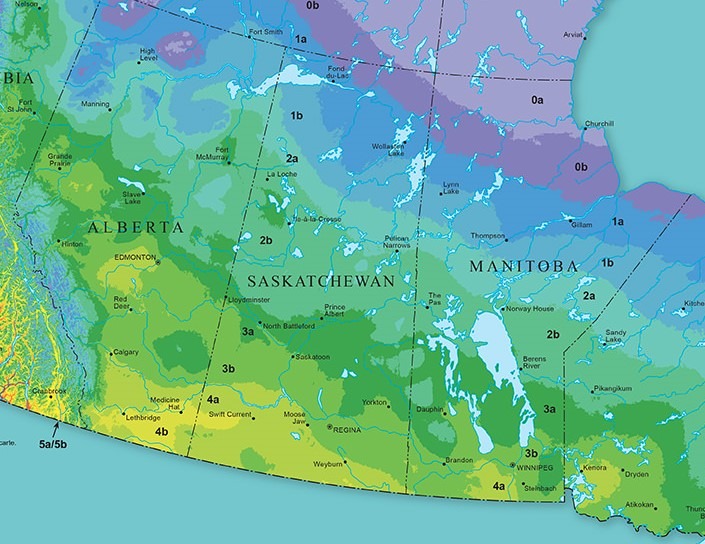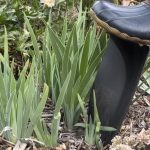Plant hardiness zones are a powerful tool for professional and home gardeners. I always use them to help guide perennial plant choices for my garden.
Knowing a plant’s growing zone is another piece of the puzzle in deciding if the area you want to plant is a viable option – alongside how many hours of direct sun, how much wind, and the type of soil a growing area has.
Do you use a plant hardiness zone rating system?
Lean in with me and let’s talk about what plant hardiness zones are, what information plant hardiness zones reveal, and how to use plant hardiness zones for your garden planning.
What are Plant Hardiness Zones?

Plant hardiness zones are known by several names. They are called growing zones, horticultural growing zones, and horticultural hardiness zones, and they all mean the same thing.
Plant hardiness zones are a framework initially developed in North America to guide government agencies in agricultural and horticultural policy decision making. The United States got the ball rolling in the early 1960s, and Canada followed suit a few years later.
This system proved to be very useful for governments, and an unintended outcome is that it has been incredibly practical for home gardeners, too.
The plant hardiness zone system has two components:
- A geographical rating component and
- Individual plant ratings
When plants are matched correctly with their hardiness zones, they should grow successfully with proper care and TENDing and if the sun, wind, and soil conditions are right, too.
Related: Find out more about TENDing your garden with the principles of How to Keep Hanging Baskets and Flower Containers Thriving all Season and download the free pdf here.
Plant Hardiness Zones – The Regional Zone Rating System
The geographical rating component of plant hardiness zones sets out to group physical regions that experience similar growing conditions, called zones.
In determining these zones, seven environmental factors were studied:
- Minimum yearly temperature
- Maximum yearly temperature
- Number of frost-free days
- Summer rainfall
- Snow cover
- Top wind speeds and gusts
- January rainfall
In North America, Canada has 9 plant hardiness zones (Zones 1-9), and the United States continues up to Zone 11.

Zone 1 is the coldest, and Zone 11, at the tip of Florida, is the warmest. Canada’s warmest region, Zone 9, is in the most southern part of Ontario, which is the same latitude as northern California.
Each plant growing zone is further divided into group ‘A’ and group ‘B’. Group ‘A’ is slightly colder than group ‘B’.
The entire world is now divided into growing zones, and Canada made their most recent updates in 2015.
Plant Hardiness Zones – The Individual Plant Rating System
Most plants are cataloged for the zones they will grow in, including:
- Annuals – plants that complete their life cycle in 1 year
- Biennials – plants that complete their life cycle in 2 years
- Herbaceous Perennials – plants that live longer than 2 years and grow fresh from their roots in the ground each spring
- Woody Perennials – plants that have woody stems or trunks and continue their growth where they stopped growing in the fall, which includes trees, shrubs, and some vines
The ratings assigned to plants are expressed in a range to reflect the various conditions in which they will grow.
Here’s an example: Most Peonies are rated as zone 3-8, meaning that zone 3 is the coldest region they will grow in, and zone 8 is the warmest they will tolerate.
How to Find Your Plant Hardiness Zone
It’s pretty straightforward to find your plant hardiness zone. Canada and the US have easily accessible and detailed Plant Hardiness Zone maps on the internet. Maps of countries, individual provinces, counties, or states are also easy to find.
Key phrases to look for in hardiness map searches include ‘plant hardiness zones’, ‘horticultural growing zones’, ‘plant growing zones’, ‘plant hardiness zone maps’, ‘zone hardiness map/s’.
Once you find a legible, detailed hardiness zone map, find your location on it, and match it to the map index. Most maps are colour coded and all you need to do is match the colour on the index.
What if your neighbourhood is between 2 different plant zones?
If your garden is on the border of 2 different hardiness zones, plants from both zones will grow there, and you can do some experimenting!
If you’d like to start safely, grow plants in the lower zone and try plants in the higher zone as you have success and you may find that some plants in the higher zone may not grow in your area.
How to Use Plant Hardiness Zones Ratings for Your Garden Planning

Here’s where the plant hardiness zone rating system works so well for gardeners.
When it comes to choosing perennials, the gardener’s job is that of a matchmaker, pairing the right plants with the right zone.
Once you know your growing zone, always check the plant ratings before you buy any perennials, trees, or shrubs for your garden. They should have tags that indicate their variety name, expected mature height and width, sun exposure requirements, and zone rating.
But sometimes you come to discover that your plants didn’t survive the winter. There are several reasons why plants die over the winter like age, level of hydration, exposure to dramatic temperature fluctuations, and zone hardiness mismatches.
Related: For more on garden planning, see How to Plan & Design a Garden in 4 Simple Steps.
Why Plant Hardiness Zones Can Seem Inaccurate
It’s important to remember that plant hardiness zones are a compilation of average climatic conditions.
Whenever you work with averages, there are always outliers that live external to the boundaries. These are called climate envelopes.
Climate Envelopes
Climate envelopes are areas where plants grow beyond their assigned zone ratings.
Examples are perennials like lavender. Lavender has a zone rating of 5-9, but it also can grow in zone 4, or Heuchera (Coral Bells) has a zone of 3 rating that won’t grow in zone 4a.
What causes climate envelopes?
Topography has a strong influence on climate. Features like hills, valleys, forests, and mountains impact rainfall, snow cover, and average temperatures.
Bodies of water like creeks, rivers, sloughs, and lakes have a moderating effect on temperatures, moderating cold in winter and cooling down heat in summer.
Topographical features can also be human made. Fences, buildings, sky risers, villages, towns, and cities have a warming effect.
For example, the city of Edmonton, Alberta, is a warmer space than its outlying communities because of the buildings and human movement within its borders. Buildings block wind, collect heat from sunlight, and emit that warmth in the winter and summer.
Each gardening space is different and unique because of external factors like those listed above and that is why gardens can grow different perennials even though they are in the same zone right next to each other.

Zone Ratings Vary Among Plant Families
As mentioned earlier, all plants are assigned zone ratings expressed in average ranges.
Perennial plant variety zone tolerances tend to arrange together in family clusters on a bell curve, but there are exceptions that pop up on either side of the spectrum.
You will find that some varieties of the same family can handle temperatures that are a little colder, and others can’t. The trick is to find the ones that do well in your garden, and it may take a little experimenting to see who they are.
Zone Ratings can be Inflated
As you gain experience as a gardener, you will begin to understand which perennial plant brands have ‘optimistic’ zone ratings and which have more realistic ones. This means that some suppliers give plants a lower zone than they can actually tolerate.
The Right Plant for the Right Place

One of the keys to gardening success is to know your garden environment. Know how many hours of direct sun it gets, note the wind pattern, familiarize yourself with the soil quality and how it drains, and know your plant hardiness zone.
Once you are equipped with these pieces of information, all you need to do is find the plants that pair with your garden, and you will have a match made in heaven!
Who knew that a gardener was a matchmaker?
©Sharon Wallish Murphy ©Gardening with Sharon































